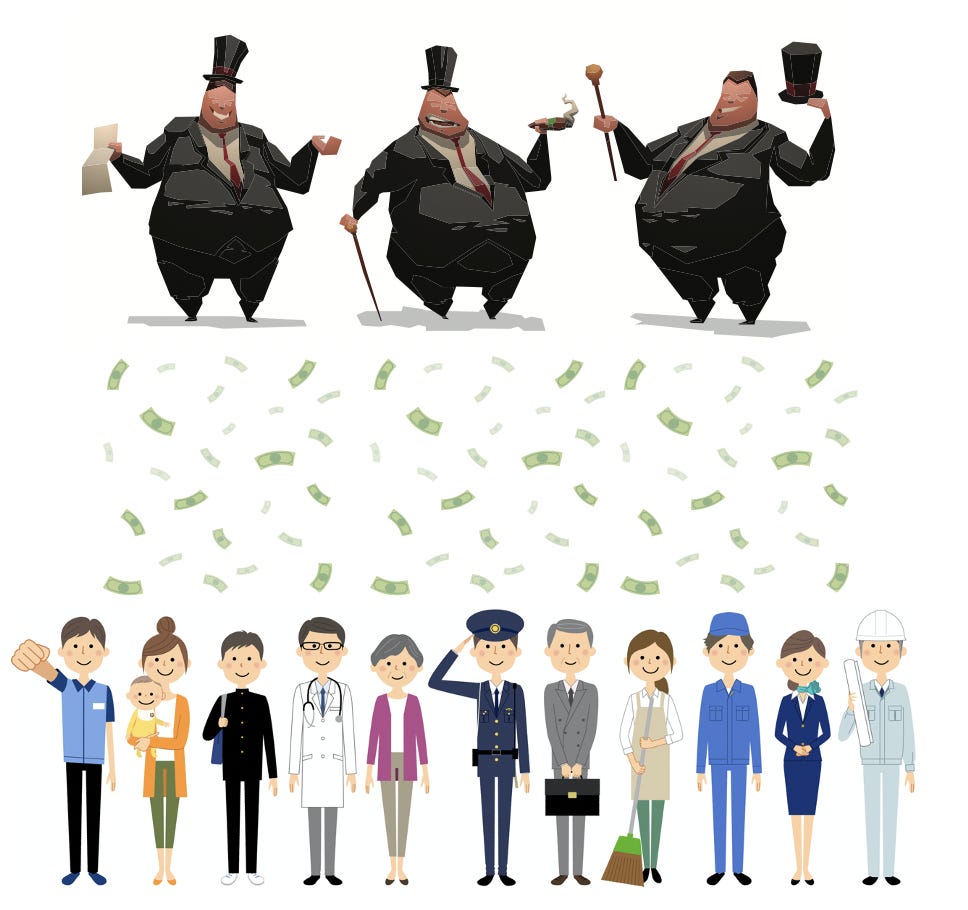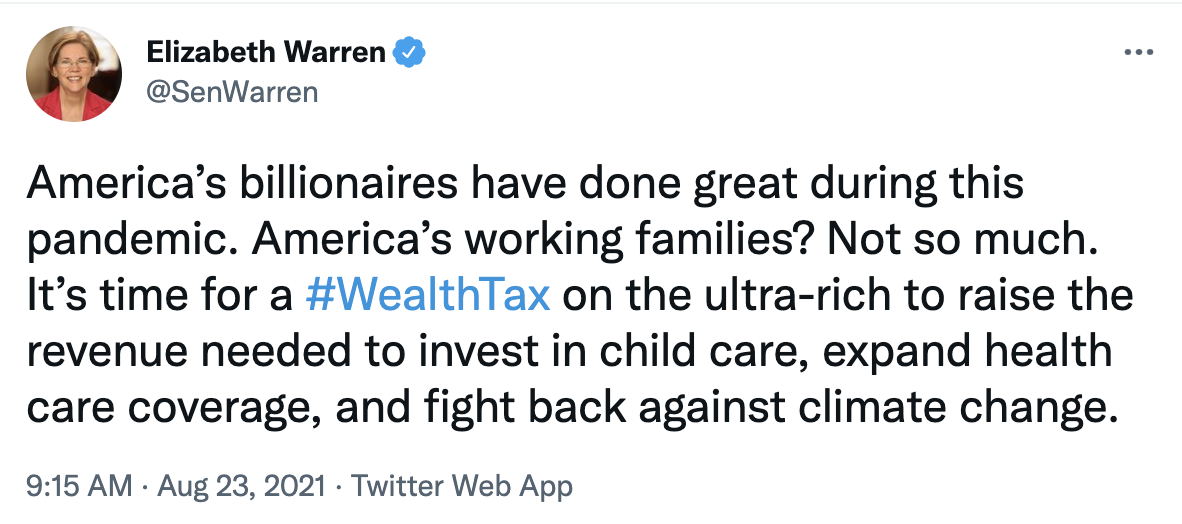What Every American Needs to Know About the Congressional "Pay-For" Game (Part 2)
Why It's a Swing and a Miss For Me
Last week, I wrote about America’s favorite pastime. Baseball, of course. The purpose of the post was to expose the Congressional “pay-for” game for what it really is—political theatre masquerading as sound finance.
I’ve been writing and speaking out about this for more than two decades, and it looks like the message is finally beginning to break through. But we have a long way to go.
The Rich Will “Pay For” It
By now, everyone knows that the Senate passed a bipartisan infrastructure bill, and that it is working on a so-called “soft” infrastructure package that could result in the passage of a $3.5 trillion reconciliation bill in the coming months. My previous post explained how the bipartisan deal was accomplished by calling a “rain delay” on the whole “pay-for” game. Now, everyone is watching to see whether—and how—the next package will be “paid for.”
Within the halls of Congress, this is mostly a numbers-on-paper game. Outside the beltway, it’s more about messaging those numbers. Think “how” versus “who.”
“How will you pay for it?” is the numbers game. This is where lawmakers try to stitch up the legislation so that they come as close as possible—on paper—to being able to claim that they’re not adding to the deficit so the spending is “paid for.” Almost no one on the outside cares how Congress finesses the numbers to play the “pay-for” game. What most people care about is what it means for them. “Who will pay for it?” is the bigger concern for most Americans.
Democrats have settled on an answer to that question. The rich will pay for it.
Following the Biden administration’s lead, Democrats are working to craft legislation that they can message as “fiscally responsible” while allowing the president to keep his promise to the American people.
“So, here’s what I’d do. I start with one rule: No one — let me say it again — no one making under $400,000 will see their federal taxes go up. Period.”
The man who will ultimately stitch up the numbers on the reconciliation package is Senate Budget Committee Chairman, Bernie Sanders (I-VT). In addition to using the media and the press to build support for the $3.5 trillion package, Sanders, a tireless crusader for the working class (and against the “billionaire class”), has taken his case directly to the people of Indiana and Iowa.
The message is simple: It’s time for large, profitable corporations and the richest people in America to pay higher taxes so that everyone else can have a better life.
Many of the lawmakers I have talked with over the years like this messaging. It’s easy to see why. It’s compact enough to fit in a TV sound-bite. And, it answers the inevitable “How will you pay for it?” question in a way that appears both fiscally responsible and morally righteous. Those who have avoided paying their “fair share” of taxes should pony up for the sake of the greater good.
It’s messaging that resonates with the most progressive members of congress. For example, here’s a tweet from Congresswoman Pramila Jayapal (WA-07), Chair of the Congressional Progressive Caucus:
That’s a pretty simple pitch. Let’s build a better society and get the rich to pay for it.
This newsletter is called The Lens for a reason. My research and policy analysis is grounded in a macro framework known as MMT or Modern Monetary Theory. MMT is the lens through which I analyze the macro economy and evaluate economic policy. Please bear that in mind as you read on.
The “Two Itch” Problem
So what happens when we look at the “pay for” debate through an MMT lens?
Peering through the MMT lens, we understand that the federal government—as the issuer of the currency—never needs to raise taxes or borrow from anyone in order to finance its spending. Moreover, the money we send to the IRS in payment of taxes each year isn’t actually used to pay for anything.1 It’s true that there is a ledger entry to account for the funds the Treasury collects over time, but the federal government isn’t actually using “taxpayer dollars” to pay for anything.
Think about it like this. Delta Airlines issues #SkyMiles, which can be redeemed for air travel by returning them to their issuer. Each day, Delta redeems lots of #SkyMiles. And, throughout the year, Delta awards #SkyMiles to millions of people. These things happen independent of one another. To issue #SkyMiles, more points get typed into a #SkyMiles account. To redeem #SkyMiles, points are deleted from a passenger’s account. Delta doesn’t hold any #SkyMiles in a vault, and it doesn’t use the old miles to issue new ones. It’s just a ledger system, where the issuer keeps one set of entries to keep track of how many new miles are issued and another to record how many old miles are redeemed.
The same thing happens when the federal government spends and redeems its currency in payment of taxes. (The US dollar functions as a tax credit. See here for further reading.) But that’s not what the “pay for” proponents would have us believe.
What we’re hearing is that Democrats are going to tax the rich and use the money to pay for more resilient infrastructure, more affordable housing, better health care, some free college, and much more. Instead of trickle-down, think shifting-down. By shifting money out of the bank accounts of the fat cats on top and into the bank accounts of those below, Democrats promise a world in which we can afford to feed a hungry kid, expand Medicare, and tackle our climate crisis.
For some Democrats, this looks like a win-win. They get to scratch two itches at once. Soak the rich and build an economy that works for the working class. Robin Hood to the rescue!
So, what’s wrong with that? What am I, some kind of stalking horse for the rich? Shilling MMT to protect the fat cats from paying higher taxes? Hardly.
But I do have a number of problems with the “pay for” game and how it’s being played. Not because I’m opposed to raising taxes on the rich—my keynote at the inaugural conference of the Patriotic Millionaires makes that clear at 2:22:30—but because I filter everything through an MMT lens.
Here’s what I see as the most problematic aspects of the “pay for” game.
It perpetuates the household budgeting fallacy
It makes it harder to do good things
It centers the rich in our collective well-being
It ignores inflation risk
First, and fundamental to MMT, the federal government is the issuer of the currency, and the rest of us are mere mortal currency users. Government budgets don’t work like household budgets. Mapping out a plan to scrape together the revenue to “pay-for” the reconciliation package reinforces a flawed household budgeting narrative. Here I am with Warren Mosler, explaining this almost a decade ago.
Second, if Democrats dig in and commit to fully “paying for” the reconciliation package, they will have to pick—and win—two fights within their own caucus. Not only will they need to hold the entire caucus together around the $3.5 trillion itself, but they’ll need unanimous support for the slew of “pay fors” to keep it all deficit neutral. If we’re being honest, there just isn’t a hearty, party-wide appetite for a wealth tax, raising the corporate income tax rate to 28 percent, or taxing capital gains as ordinary income. Even allowing Medicare to negotiate prescription drug prices might prove too heavy a “pay for” lift for certain Democrats. If that’s the case, then Democrats will have to decide whether they’re willing to do “soft” infrastructure the same way the Senate agreed to do “hard” infrastructure earlier this month, namely by shrugging off the pay-fors and allowing some of the spending to fall onto the deficit.2 I’m all for watching lawmakers work to make the tax code more fair, but I’d hate to see the the Democrats start paring back a spending package to “fit” whatever price tag they consider “affordable” given the “revenue” they think they have to work with.
Third, and this relates to #2, I have a big problem with centering the rich in this way:
Instead of just building a clean case for a wealth tax, it gets stitched up with the proposed spending so that the means justify the ends. So it becomes an if-then problem. If we can successfully wrest a few trillion from the fat cats at the top of the income distribution, then we can scatter some support down to the rest of our people and our planet. If we can’t get 50 votes to raise trillions to offset the spending, then I guess it’s tough luck for all of those families who were just lifted out of poverty with the stroke of a (deficit spending) pen. No food or shelter for the poor, no care for the elderly, and no action on the climate front. We can’t do it without the rich! They are our “pay-fors.” We need them.
Here’s how I put it when Anand Girihardadas, asked me whether I consider this messaging a problem:
“In addition to getting the economics wrong, I believe it is politically harmful to pretend that we cannot afford to fix our crumbling infrastructure, or care for our people, unless and until we successfully wrest part of Jeff Bezos’ fortune away from him.
And here’s how I put it in The Deficit Myth:
THE CRIME OF the tax bill signed by President Trump in 2017 is not that it added to the deficit but that it used the deficit to provide help to those who needed it least. It has widened inequality, putting more political and economic power into the hands of the few. MMT understands that building a better economy isn’t contingent on raising enough revenue to pay for the things we want. We can, and must, tax the rich. But not because we can’t afford to do anything without them. We should tax billionaires to rebalance the distribution of wealth and income and to protect the health of our democracy. But we don’t need to crack open their piggy banks to eradicate poverty or to have the federal job guarantee with a living wage that Coretta Scott King fought for. We already have the tools we need. Feigning dependence on those with incredible wealth sends the wrong message, making them appear more vital to our cause than they actually are.
Finally, it must be recognized that because of the way the “pay-for” game is being played, Democrats are signaling that they’re more focused on keeping the deficit in check than keeping a watchful eye on inflation. It’s an unpopular observation, so I’ll let my friend Dean Baker make it. (lol)
“Okay, but those points aside, how should we think about proposals to tax the rich from a MMT perspective. First, we know we can raise more money by taxing the rich, so if the point is to raise revenue, that is where the money is.
But we know the point of taxes is not actually to raise revenue, the point is to reduce consumption to decrease demand in the economy. Here’s where the story looks less good. Suppose we tax away 70 percent of the income over $10 million a year of our Silicon Valley billionaires and Wall Street high flyers, instead of the current 37 percent.
Do we think this additional tax bill will reduce the number of times Bill Gates or Jeff Bezos goes out to dinner? Will they take fewer vacations or buy fewer cars, planes, and yachts? While I’m sure the effect will not be zero, especially for lesser billionaires or mere hundred millionaires, taking another $70 billion a year in taxes from these people will not have nearly as large an impact in reducing consumption as taking $70 billion out of the pockets of low and middle income people. (This is just the flip side of the argument that if we want to stimulate the economy in a downturn, a tax cut will be far more effective if it is directed towards people at the middle and the bottom of the income distribution, than people at the top.)”
Now, Dean wrote this back in February 2019, before COVID-19 ravaged our economy. And while it remains true that the tax increases Democrats are pursuing won’t do much to depress their consumption, it’s also less risky to get it wrong today versus back in February 2019, when the unemployment rate was 3.8 percent. It’s also true that many of the things Democrats are pushing for will mitigate inflationary pressures. Negotiating prescription drug prices is a very nice dis-inflationary policy. Medicare-for-All would do even more to dampen health care costs, a major contributor to headline measures of inflation. Building and modernizing physical infrastructure and investing in child care, health care, and education also boost productivity and build capacity over time. So I’m not sounding the inflation alarm bell with respect to the $3.5 trillion. I’m just pointing out that when it comes to the “pay for” game, we’re getting a lot of things wrong.
I have more to say on this, so stay tuned for Part 3. And please consider sharing and subscribing to The Lens so that we can continue this journey together.
Taxes are important for many reasons, and bond sales serve other functions. It can take some time to wrap your head around these arguments because they run completely counter to what we have all been taught. For what it’s worth, I didn’t believe it myself until I spent months researching the actual mechanics of government finance. I wrote about that experience in my book. That research culminated in the peer-reviewed article, which is what eventually got me over the hump.








Can you explain how negotiating prescription drug prices is dis-inflationary